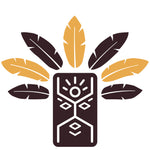
The Guide, the Shaman, the Keeper: Roles in Sacred Ceremonies
Why These Roles Matter
From the highlands of the Maya to Hmong mountain villages to North‑American fire circles, people gather around ritual to heal, learn, and remember. A ceremony is not improvisation. It works because three archetypes share the load:
• Guide — the road‑map keeper
• Shaman — the heart of the work
• Keeper — the guardian of space, fire, and time
Understand their duties and you shop for shaman supplies with purpose instead of guessing.
The Guide — Navigator of the Inner Journey
The Guide meets you long before the drum begins. Screens your health, sets diet rules, opens a channel for questions.
Main tools:
• Smudge kit with sage and sacred herbs for energy cleansing.
• Condor feather for wafting smoke.
• Medicine bag that carries seeds, stones, and a tiny calendar.
Tip: Many beginners buy a ready “Journey Starter Pack” in a reputable shamanic store instead of hunting pieces one by one.
The Shaman — Heartbeat of the Ceremony
The Shaman stands between worlds. Songs, breath, and plants form his language. According to Mayan legends, he climbs the World Tree; Hmong elders drum until spirits answer.
Working methods:
• Icaros, throat singing, or cedar chanting.
• Altered states via rhythm, breath, or herbal tinctures.
• Holding the energy field when hard emotions surface.
Core shamanic tools:
• Hand‑made shamanic rattle filled with river seeds.
• Elk‑hide shaman drum tuned to 4 b.p.s. — the human resting heartbeat.
• Staff or power stick carved with cosmograms.
Every serious shaman store keeps a shelf for certified rattles and ethically sourced herbs. Choose instruments that list artisan, origin, and fair‑trade proof.
The Keeper — Guardian of Fire and Time
While others travel inward, the Keeper — often called Fire Keeper or Keeper of Time — stays fully alert. He controls three assets: fire, silence, and schedule.
• Keeps the ceremonial fire alive, feeding it with cedar or copal chips.
• Checks the 260‑day calendar among modern Maya, ensuring correct portal days.
• Maintains grounding: fresh water, blankets, and exit paths.
Inventory:
• Basalt stones for a stable fire base.
• Copper bowl for embers.
• Compact ceremonial fire kit sold in specialist shamanic stores.
Quick Reference: Who Uses What
|
Role |
Key Items |
Where to Find |
|
Guide |
Smudge kit, feather, medicine bag |
Starter section of a shamanic store |
|
Shaman |
Shamanic rattle, shaman drum, staff |
Handcrafted aisle, shaman supplies catalog |
|
Keeper |
Fire kit, ember bowl, basalt stones |
Outdoor / shaman store fire‑keeper kits |
|
Hmong |
Bronze bells, pentagonal cane, spirit daggers |
Niche “shaman tools” vendors |
How to Choose a Reliable Shamanic Store
1. Ethical sourcing. Does the shop pay makers at village rates or world rates?
2. Transparent plants. Herbs must carry Latin names and harvest permits.
3. Community give‑back. A solid seller donates at least 5 % to the tribe whose craft they sell.
Case in point: one online shaman store funnels part of every shamanic rattle sale into rebuilding a Guatemalan school destroyed by storms.
Closing the Circle — Where to Begin
A successful ceremony is never solo work. Guide, Shaman, Keeper weave a net that holds you while you fly.
Browse our curated range of shamanic attributes — each piece traced back to its maker.
Need a full checklist? Book a free call and our team will match you with the exact shamanic tools you need for your first or hundredth ceremony.
Sacred practice starts with the right people — and the right tools.

Dejar un comentario